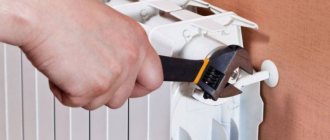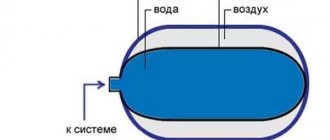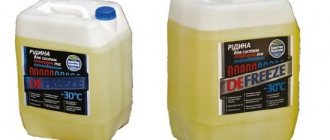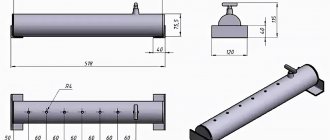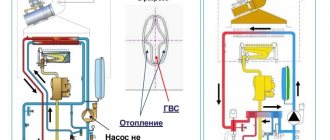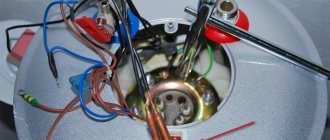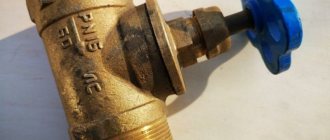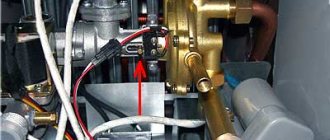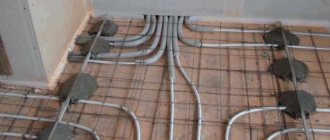Almost every modern home has a water supply system, the obligatory element of which is a hydraulic accumulator for water. At the same time, some private property owners are wondering why it is needed at all, is it possible to do without it? In this article we will try to find out.
This knowledge will help you avoid many problems that may arise during operation. By the way, hydraulic accumulators are widely used not only in everyday life, but also in industry.
What it is?
The hydraulic accumulator, as well as a hydraulic or expansion membrane tank, is presented in the form of a can with thick walls. Inside it is either a membrane or an elastic balloon. The device will be discussed in more detail in the next section. There are two types of hydraulic accumulators:
Moreover, each of them has its own characteristics. Horizontal hydraulic tanks are best connected to surface pumping equipment. While when using vertical devices, it is better to give preference to submersible pumps that are installed in a separate room.
Typically, hydraulic tanks whose volume does not exceed 100 liters do not have a safety valve. Therefore, in order to bleed the air, it is necessary to completely empty the container.
Just as a hydraulic accumulator for water is a mandatory element of the water supply, any type of it must be equipped with a system for bleeding air. Otherwise, excess oxygen leads to the formation of air pockets, which do not have the best effect on the performance of the entire system.
Why is an expansion tank needed in a heating system?
The expansion tank is one of the important elements of the heating system. It is necessary to receive excess water, which is formed during thermal expansion of water as a result of heating. Purpose: ... And water has a peculiarity: when the temperature rises, it increases, and when the temperature decreases, it decreases.
Interesting materials:
What mushrooms are collected in spring in Ukraine? What icons are for blessing? What labor safety instructions should be developed for the employee? What instruments belong to the wind group? What interesting books are they reading now? Which commemorative coins are the most expensive? Which of the following risks are social insurance? What products are made from sand? What insulators? What qualities should an astronaut have?
Main necessity
To understand exactly what the need for this equipment is, it is enough to refer to its direct responsibilities. Anyone who has a water supply system in a private home knows that in addition to the hydraulic tank, it includes pumping equipment. And if there are no additional devices, then the pump turns on whenever water is consumed: taking a shower, washing dishes and other household needs.
Such frequent switching on and off leads to rapid equipment failure. Moreover, not only the pump itself, but also the entire system can suffer. Each time the pressure jumps abruptly, and this is nothing more than a water hammer. For this reason, a hydraulic accumulator for water is installed, which allows the pump to operate in moderate mode.
That is, every time you need to wash your face or just wash your hands, the pump will not turn on, since the water flow is small. In this case, he rests peacefully, since the resources of the hydraulic accumulator are used (while there is still water in it). But as soon as it drops to a certain level, the equipment begins to work and replenish the liquid supply.
Installation of several hydraulic tanks
Some users are faced with the problem of how to connect an additional tank to the water supply line if there has been an increase in consumption or the volume of the storage tank is too small for normal operation. Installing two hydraulic accumulators is not particularly difficult; they can be assembled by connecting them in parallel, using an additional adapter fitting, a flexible hose or cutting a water pipe.
The advantage of a system with two tanks is its high reliability in case the rubber membrane ruptures in one of them.
Rice. 8 Hydraulic tank in the frequency control unit for pumps
Other functions of the accumulator
The main reason for the need for such an element of the water supply system has already been figured out, but its functional purpose is not limited to this. Other equally important functionality includes:
- Pressure stability. Even if several taps are open in the house at the same time, everything is compensated by the accumulator itself. Otherwise (without it), a sharp drop in pressure cannot be avoided. If hot water is used in the system, then the consequence of such changes will be temperature changes.
- Stock Power outages are infrequent, but inevitable, so it is worth having some kind of reserve for such an eventuality.
- Protection against water hammer. This phenomenon occurs periodically, and many cope with this by smoothly turning the shut-off valves on and off. But it is much better to initially include a hydraulic tank in the system.
- Protects the pump. There is already a certain amount of water in the working chamber, which prevents the equipment from working in constant mode.
There is a good alternative on the market in the form of pumping equipment, which, thanks to a number of manufacturers, is specially adapted for pumping water without a hydraulic accumulator. The whole scheme is very simple, but it requires certain knowledge regarding the correct configuration of such equipment. In addition, the cost is several times higher than simply installing a pump with an additional tank.
It is no coincidence that in the private sector now almost every owner who wants to establish a water supply in his home is thinking about whether or not to install such a device. The answer, of course, is clear – bet, because the existing advantages are simply difficult to underestimate.
Chemical flushing of the system when needed and how to do it
The frequency of chemical flushing depends on the quality of the water used. Many people do not flush the system at all; in the case of a special coolant, this is normal practice. But the use of water is associated with the formation of scale and other deposits, which reduce the efficiency of heat transfer and significantly increase fuel consumption.
Flushing the system is carried out using a special pumping unit, which can be rented for a while. The system is washed with a special solution of cleaning chemicals, which is selected according to the type of pipes, radiators and heat exchanger material in the boiler. In special cases, the boiler is washed separately.
When flushing, it is important to close the taps of all auxiliary equipment: expansion tank, pumps, bleed valves, etc. At one point, the pipeline ring must be closed, and on both sides of the valve there are connections for connecting flushing hoses
At one point, the pipeline ring must be closed, and on both sides of the valve there are pipes for connecting flushing hoses.
Flushing is carried out in two stages: first, the system is pumped with a chemical solution for 40-60 minutes, then the chemical is washed out with clean water several times.
Equipment design
It is important for any owner of a house with a water supply system not only to know what the need for such a main element is, but also to understand its operating principle, including how to drain the water from the accumulator. The last one is at the end of the article.
The term “membrane tank” is not used by chance. In addition to the fact that such containers are divided into horizontal and vertical, they can be classified in another way:
The first case is just a membrane tank. That is, inside it there is a special elastic partition that divides the entire volume into two chambers: for air and water. The membrane itself is a non-removable element and therefore, if it breaks, the entire hydraulic accumulator must be replaced. Fortunately, they are durable.
In balloon devices, instead of an elastic partition, there is a pear-shaped working element made of almost the same material as the membrane, which allows it to stretch to accommodate the required amount of water. In this case, the internal container can be replaced.
Moreover, the division into chambers is made in such a way that the water does not come into contact with the inner metal surface of the accumulator. The air chamber is equipped with a pneumatic valve, which is responsible for regulating the pressure. It is usually filled with air, nitrogen or some other inert gas. Due to the connecting pipe, the working container is filled with water. In order to control the operation of the pumping equipment in automatic mode, a pressure switch is provided, which is also connected to the hydraulic accumulator.
Determining a location for a water supply station
When choosing a location for a pumping station, you need to focus on the characteristics of the hydraulic pump. Every ten meters of a horizontal pipe between the water source and the pump reduces its suction capacity by 1 m. If they are expected to be separated at a distance of more than ten meters, then the pump unit model must be selected with an increased suction depth.
An automatic station for an autonomous water supply system can be located:
- on the street in a caisson near a well;
- in an insulated pavilion built specifically for pumping equipment;
- in the basement of the house.
The stationary external option involves installing a caisson and laying a pressure pipe from it to the cottage below the ground freezing level. When installing a pipeline that operates year-round, its laying below the depth of seasonal freezing is mandatory. When installing temporary summer pipelines for the period of residence at the dacha, the pipeline is not buried below 40 - 60 cm or is laid on the surface.
If you install the station in a basement or basement, you will not have to worry about the pump freezing in winter. You just need to lay the suction pipe below the freezing line of the soil so that it does not freeze in extreme cold. Often a well is drilled right in the house, which then significantly reduces the length of the pipeline. But such drilling is not possible in every cottage.
Installation of water supply pumping stations in a separate building is possible only if the equipment is operated during periods of positive temperatures. However, for areas with very low winter temperatures, this option, designed to operate all year round, must be insulated or a heating system installed. It is better to immediately install the pumping station directly in the heated house.
When choosing a location for a water supply station, it is necessary to take into account the temperature limits specified in its passport by the manufacturer:
Principle of operation
How does the device we are considering work? As can be understood from the previous section, the hydraulic accumulator for water is not particularly complex in structure. And in fact, the principle of its operation is based on the ability to accumulate hydraulic energy.
When the pumping equipment is turned on, water begins to fill the working container, and it stretches, increasing in size. Thus, it begins to compress the air or gas of the second chamber, thereby creating a certain pressure. As soon as it rises to the set value, the connected relay will send a signal to the pump and it will turn off.
Under the influence of this pressure, water from the working chamber enters the water supply system - you just have to open the tap and the water will flow. Over time, the amount of water in the chamber decreases, which leads to a gradual decrease in pressure in the gas chamber. And as soon as it drops to a certain minimum, the same relay will command the pump to start working. After this, the whole cycle repeats.
It is important to take into account that the frequency of operation of the pumping equipment completely depends on the volume of the hydraulic accumulator and the degree of water use. The optimal tank volume is 100 liters. This amount is quite enough for household needs. In this case, the relay can operate up to 10-15 times within an hour, and with economical use of water - about 5 times.
Prepare your lawn for winter
The first step is to clear the lawn of debris. A layer of fallen leaves or branches will inhibit photosynthesis and can also provide an excellent home for pathogens and pests. The lawn also needs to be mulched to preserve the sown grass and reduce moisture evaporation. Do not forget about cutting the grass - this procedure in the middle zone can be carried out until the end of October. Moreover, the mowing height should be 1-2 cm higher than usual (i.e., if during the season you cut the lawn to 4 cm, now the grass height should be 5-6 cm).
In the first half of October, do not forget to feed the lawn with phosphorus-potassium or special autumn lawn fertilizer (according to the instructions). If holes and bald spots have formed on the cover, they need to be “patched” by adding soil and sowing seeds.
A pressure switch wouldn't hurt either.
It is this sensor that is responsible for the automatic operation of the pumping station, monitoring the water pressure in the accumulator. Also thanks to it, the pressure of the working chamber is adjusted. The relay works through some manipulations:
- The pressure exceeds the permissible values - the contacts open (the pump turns off).
- A drop in pressure below normal causes the contacts to close (the pump turns on).
Such a device also has its own membrane, which bends and unbends depending on the pressure. It is thanks to this that the contacts in the mechanism are switched.
The combination of a hydraulic accumulator and a relay is a reliable system for high-quality and comfortable operation of the water supply system. And it doesn’t matter what we’re talking about: private houses, outbuildings, and so on.
Recommendations
It makes sense to leave the devices open for a while and let the moisture dry out. This can be done indoors where there is no wind and dust does not fly. This requirement is especially significant for equipment that is sensitive to solid particles. Breakage will not happen, but the abrasive will damage the mechanical components.
It is necessary to drain any water from flexible hoses that may remain in the kinks. To do this, the hose must be lifted sequentially until liquid stops flowing from the end hole. There is nothing complicated. The main thing is to show a little attention, and the spring mood will not be overshadowed by anything.
Relay connection
The sensor is connected not only to the water supply system itself, but also to the electrical part. To connect to the water supply, choose a convenient place using flexible tubes and various fittings. All threaded connections must be sealed using flax or fum tape. It would be a good idea to install a pressure gauge to monitor the pressure in the water supply system. Some models of membrane tanks are already equipped with such a device, which is convenient if it is necessary to drain water from the accumulator.
As for the electrical part, it is not necessary to allocate a separate line for the relay, but in order for the device to work longer, it is still worth taking care of it. To do this, run a separate solid copper conductor from the distribution panel with a diameter and a cross-sectional area of 2.5 mm 2, no less. It is also worth including a combination of automatic + RCD or differential automatic.
Since the relay itself does not consume much electricity, you need to be guided by the parameters of the pump. Electricity and water are a bad combination, and therefore grounding is needed. Under the cover of the device there is a block for connecting different wires:
- grounding;
- a pair of line contacts is used to connect phase and zero from the electrical panel;
- the third pair is used to connect wires to pumping equipment.
Now all that remains is to check all threaded connections for leaks and proceed, if necessary, to adjusting the relay.
How to blow out water pipes in a country house?
The pipes are blown
using a compressor, but not too powerful, since
pipes
can withstand a pressure of a maximum of 8-10 atmospheres. - remove all plugs, remove plumbing fixtures, remove all blockages in pipes.
Interesting materials:
Is it possible to plant a green acorn? Is it possible to plant honeysuckle in July? Is it possible to plant honeysuckle in the shade? Is it possible to plant potatoes after strawberries? Is it possible to plant cucumbers after strawberries? Is it possible to plant garlic after strawberries? Is it possible to plant cucumbers after onions? Is it possible to plant cucumbers after carrots? Is it possible to plant garlic after cucumbers? Is it possible to plant garlic after cucumbers?
Features of relay adjustment
Before buying a relay, you need to find out the operating pressure limits of the pumping equipment and hydraulic accumulator. It is important that these parameters of all three components correlate with each other. How to adjust a water pressure switch with a hydraulic accumulator? The answer is in simple instructions:
- Open a tap or hose and, while consuming water, find out from the pressure gauge at what value the pump will turn on. As a rule, this is 1-1.5 bar.
- Then you need to turn off the water to now find out at what pressure the pump will turn off. Optimal - 2.5-3 bar.
If it is necessary to set other pressure values, you need to remove the mechanism cover, under which there are springs with nuts. The large one regulates the pressure value at which the pump starts. The smaller one, as you can understand, is that the equipment turns off.
The pressure values are adjusted using nuts: to increase the threshold, they are tightened clockwise (tightened). If you need to lower the threshold, accordingly, they are unscrewed counterclockwise (weakening). Due to the high sensitivity of the nuts, you should not turn them 360° or more at once.
Treat basement and cellar for mold
The end of the dacha summer season is a good time to treat the cellar and basement so that the “kingdom of mold” does not begin in them in winter. First of all, in dry weather, remove all the cans and dry the room, then treat the walls and other structures with an antiseptic (this procedure must be repeated every few years).
As an antiseptic, you can use a solution of copper sulfate (100 g per 1 liter of water).
Those who like to radically solve problems recommend using a sulfur smoke bomb to treat the basement. Close all ventilation openings in the empty room, and cover metal parts (if any) with plastic. Make sure no one is home (you'll have to leave it for a day), then light the fuse, go out and close the doors tightly. Upon return, thoroughly ventilate all areas.
Maintenance
According to many experts, hydraulic accumulators, like any other equipment, also require timely maintenance. As a result of active use of the water supply system, the pressure in the air chamber is significantly reduced. This process is natural, and no one is immune from it.
For this reason, in order to compensate for this shortcoming, it is necessary to turn off the water pump and completely empty the hydraulic accumulator. According to the recommendations of professionals, this should be done every 10-12 months. Thanks to this simple operation, you will be able to use the water supply in your home comfortably and for a long time.
Recommended insulation for a well made of concrete rings
| Type of insulation | Features of the material | Installation technology |
| Styrofoam | Inexpensive, has good thermal conductivity, does not deform, and does not absorb water. Not resistant to rodents and insects. Sold in the form of ready-made elements corresponding to the sizes of reinforced concrete rings. | The walls of the well are cleaned of debris, façade glue is applied tightly, without gaps. Styrofoam is attached. If the foam does not adhere well, you can secure it with concrete dowel nails. Any barrier insulation material is laid on the foam. The trench is filled with earth and compacted. |
| Extruded polystyrene foam | Resistant to low temperatures, aggressive environments, and withstands loads well. Approximately 20% more expensive than polystyrene foam, produced in the form of slabs. | Installation is no different from installing foam plastic. The joints are sealed with polyurethane foam. The insulation is wrapped with rolled waterproofing material. |
We invite you to see how a member of our portal with the nickname pdp000 insulated his well
The insulation of the blind area is made of EPS, the walls of the ring are insulated with expanded clay. An insulated lid-liner is also made.
You can insulate a well with a little blood. Here are a few methods tested on FORUMHOUSE.
- Our user with the nickname Accurate covers the concrete ring of the ring with plastic film. Since then, the water supply pipe has not frozen even once - it was heated by well water, and the water did not freeze because the film did not allow the cold to pass through.
- Our participant with the nickname Hodok has been insulating a well from the inside for 40 years. Attach two frames made of thick wire in the form of inverted letters P to the last ring at a distance of 25 cm from each other. They descend to ground level. On them, Walker places two semicircles cut out of iron - this creates a flooring on which a plastic film is placed. He covers all the cracks with the same film, puts old clothes inside and leaves the well until spring. But this needs to be done when stable frosts arrive, so that the improvised insulation does not get wet from the fumes from the well.
Draining
Most of us have a dacha, where we spend most of our time only in the summer. But with the onset of autumn, it’s time to take certain measures, namely, prepare the water supply system for wintering. To do this, you need to completely empty the accumulator. Draining water for the winter can be done according to the instructions:
- The pumping equipment is disconnected from electricity.
- All water consumers (taps, valves, etc.) are opened so that the working chamber of the hydraulic accumulator quickly squeezes out all the water.
- The suction line is disconnected from the pump.
- The hose going to the hydraulic tank is disconnected, the remaining liquid in the pump will immediately escape.
As you can see, there is nothing complicated, however, such a procedure is required so that the next time the water supply works as before.
When preserving the water supply system of a country house for the winter, it is necessary to completely drain the water from the accumulator. This precaution is associated with the risk of hydraulic tank malfunctions if it is left in an unheated room throughout the winter cold.
Preparation of siphons for washbasins, sinks, sinks.
If you have a plastic sewer system and therefore plastic traps, in theory you can force them to winterize rather than cook. The water plug in plastic siphons has a small volume, plastic has higher thermal insulation properties than metal or ceramics, in addition, plastic can be slightly deformed, so usually the water that does not have time to evaporate from the siphon before the onset of frost freezes. A little slower than a ceramic bowl or cast iron elbow and turning into an ice siphon, it does not break. If you have cast iron siphons, be sure to remove water from them in the winter. This can be done in several ways, such as using a kwacha (piston) to push the water from the siphon further down the pipe. If there is no plunger, you can try blowing it out with a bicycle or car pump, or carefully insert a cloth between the drain grate and gradually absorb all the water. After draining the water, plug the drain hole with a stopper or a rag (it is recommended to press the rag with something heavy) to prevent odors from the sewer from entering the house.
I have been using these technologies for 15 years and so far everything is reliable. And yes, don't forget to empty the tank. My friend did everything correctly, but did not drain the water from the tank. When frost set in, the seal in the tank broke, water got into the basin and froze there. As a result, we had to change the bathroom.
I hope, dear reader, that the information presented in this article has at least a little helped you understand your problem. I also hope that you can help me get out of the difficult situation I recently found myself in. Even 10 rubles of help will help me a lot now. I don’t want to burden you with the details of my problems, especially since they are enough for a whole novel (in any case, I think so and I also started writing with the working title “Ti”, there is a link on the main page), but if I’m not mistaken in your conclusions, then there will be a novel and you may well become one of its sponsors, and perhaps even its heroes.
For terminals, Yandex Wallet number 410012390761783
For Ukraine – card number in hryvnia (Privatbank) 5168 7422 0121 5641
Webmoney wallet: R158114101090
Categories:
User rating:
No
Comments:
Note. It is possible that your question, especially if it concerns structural analysis, will not appear in the general list or will remain unanswered even if you ask it 20 times in a row. Why is explained in sufficient detail in the article “Making an appointment with a doctor” (link in the header of the site).
Adding an article to a new collection
In order not to find yourself in a “broken trough” with the start of the next season, it is necessary to properly close the current season. It's time to carry out work that will help preserve the summer cottage until spring. So, here's how to prepare your cottage for winter.
You've probably already started doing the bulk of the work. We have no doubts about your experience at the dacha and, nevertheless, we suggest you check: what if something “went over your head”?
What needs to be done to empty the storage tank of residual water
It may also be necessary to empty the accumulator of water in the following cases:
- when performing repair work (replacing a membrane that has lost its tightness and/or elasticity)
- if the water supply has not been used for a long time and water has stagnated in the hydraulic tank. The water is drained to fill the accumulator with clean water from the well.
- De-energize the pumping equipment.
- Leave any of the system's water taps open.
- Disconnect the hose supplying water to the storage tank.
If the accumulator is equipped with a drain valve (drain plug), the remaining water can be drained most easily by opening the drain. In most cases, vertical hydraulic tanks are equipped with a water drainage device. If such a valve is not provided for in the design, during installation of the water supply system it is recommended to provide a way to simply disconnect the outlet pipe. An American type connecting fitting is often used.
Conservation of the Abyssinian well
The liquid in Abyssinian soil is usually lower than the point to which the ground freezes. Therefore, nothing will happen to the well in winter. The main thing was to take care of draining the water from the pipes and covering the mouth.
So what to do:
- remove the pump and hoses, drain the water from them and put them in a warm place;
- remove water from the pipes and blow them with air;
- screw the head onto the thread that was made in advance;
- cover the head with film.
It is also recommended to pour a solution of bleach (40 grams) and water into the well. For every meter of well you need a bucket of this solution.
Prevention
To prevent a breakdown of the hydraulic accumulator from taking you by surprise, you need to carry out periodic maintenance. It's easy to do:
- once every 3-4 months the tank is inspected for damage;
- Once every six months, you need to check the operation of the pressure gauge, pressure switch, and also check the air pressure level in the tank.
In addition, all experts recommend replacing the membrane in the accumulator every three years. Naturally, subject to its constant and uninterrupted use.
The fact is that the average service life of these products rarely exceeds this figure. Therefore, it is better to replace it in advance - this way you can protect yourself in advance from a sudden breakdown.
Previous articles Next articles
Related Posts
- 25.03.2017.
What is a hydraulic accumulator and how it works
- 25.03.2017.
How to choose a hydraulic accumulator and not make a mistake
- 25.03.2017.
